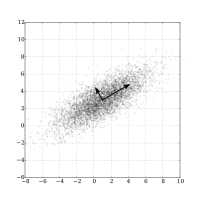
Photo from wikipedia
SYNOPTIC ABSTRACT Component selection in principal component analysis is the main step for dimension reduction and working further with extracted factors. A range of component selection methods include hypothesis testing… Click to show full abstract
SYNOPTIC ABSTRACT Component selection in principal component analysis is the main step for dimension reduction and working further with extracted factors. A range of component selection methods include hypothesis testing and subjective judgement of graphical representation of eigenvalues, and most of them are not suitable for automatic selection of number of principal components. Though several versions of description length criteria have been developed for automatic selection of principal components, each of the criteria has its own methodological advantages and disadvantages, and no single method always performs the best in all datasets. With the lack of general guidance and criteria for using a particular method, component selection procedures largely depend on personal preferences rather than real statistics. In this article, we survey theoretical grounds of three commonly used minimum description length criteria based on the inherent Karhunen-Loève expansion of the observed process, and examine their performances by employing a series of simulation experiments. Finally, we present some empirical results to demonstrate that the theoretical properties of these criteria are reflected in simulation experiments, and results obtained in simulation experiments are also reflected in real data analysis.
Journal Title: American Journal of Mathematical and Management Sciences
Year Published: 2018
Link to full text (if available)
Share on Social Media: Sign Up to like & get
recommendations!